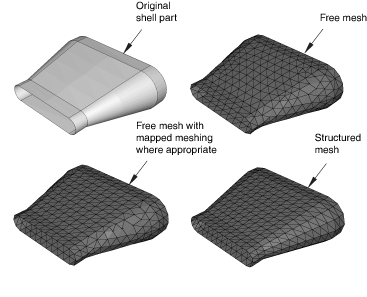When can Abaqus/CAE apply mapped meshing? | ||
| ||
it is likely that a regular mesh pattern with reasonable quality can be generated, and
any minor adjustments to the mesh seeding will not violate the user's intent (as indicated by any existing seed constraints).
When Abaqus/CAE applies mapped meshing, it makes small adjustments to the mesh seeding to ensure that opposite sides of the rectangular region have the same number of seeds. If your model is large and includes many simple regions, it may take slightly longer for Abaqus/CAE to check for rectangular regions and adjust the seeds to produce a mapped mesh than to produce a mesh without mapped meshing. However, for most models the time difference to include mapped meshing is not significant compared to the improvement in mesh quality.
Figure 1 shows a shell part meshed with triangles using the following mesh techniques and algorithms available in Abaqus/CAE:
Free meshing
Free meshing using mapped meshing where appropriate
Structured meshing

In many cases a free mesh of triangles with mapped meshing where appropriate will be the same as a structured mesh of triangles. The meshes are different in Figure 1 because Abaqus/CAE honors the original seeding and determines that mapped meshing is not appropriate on the side of the part. In contrast, when Abaqus/CAE creates the structured mesh, it significantly adjusts the seeding to create the structured mesh that was requested by the user.